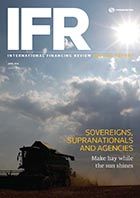The euro crisis is over. At least, that’s what the market appears to believe. Yields across the eurozone’s embattled periphery have fallen to levels not seen in nearly a decade, while rating agencies are starting to take a more positive outlook towards peripheral countries, citing progress in fiscal and economic reform.
To see the digital version of this report, please click here.
To purchase printed copies or a PDF of this report, please email gloria.balbastro@thomsonreuters.com.
Further spread compression across the bloc is almost inevitable and investors, eager for returns in a low interest rate environment, feel comfortable riding that wave.
Wise market participants will keep in mind that many eurozone countries have accrued unprecedented debt levels over the crisis years and that deflationary pressures will keep a cap on future growth. But, for now, any questions around debt sustainability and future insolvency risks are being silenced by a wave of optimism.
For its part, the European Central Bank has promised years of rock-bottom interest rates to make sure it keeps the soil fertile for the green shoots of growth.
Other major economies, though, are at different points of the economic cycle. In the US, for example, the Federal Reserve, under the leadership of its new governor, Janet Yellen, is tightening monetary policy.
The tapering of the Fed’s quantitative easing programme is already well advanced and rates are expected to rise sometime in the second quarter of next year. Money markets suggest the UK will also raise rates around that time.
The divergence in policy between major central banks has created an interesting bifurcation in markets. Ten-year US Treasuries currently yield 2.7%, while the equivalent European benchmark, German Bunds, offer just 1.5%.
Similarly, Irish five-year debt, which was junk-rated by Moody’s until earlier this year, is more expensive than equivalent UK paper.
To the casual observer, these markets must seem illogical – risk is no longer an indicator of return.
Even with these anomalies, however, there is no shortage of demand for sovereign, supranational and agency debt in the developed world.
While central bank intervention in Western economies has seen real-money interest in fixed-income products diminish, increased regulation of financial services has created plenty of demand from another group of investors.
Bank treasuries have been forced to build buffers of high-quality, liquid assets to mitigate the impact of future crises and SSA products have become the most sought after for this purpose.
Regional and agency debt is especially in demand because it offers a spread over sovereign benchmarks with little additional risk.
Many more of this type of issuer, such as local authorities and housing associations, are expected to take advantage of this latent demand to lock-in record low borrowing costs and lessen their reliance on tightening government purse-strings.
The feverish competition in the sector has been further underlined by the rise of so-called green bonds over the past year.
With a whole host of their clients eager to diversify into this area, banks are falling over themselves to pitch the business. Many have clubbed together to standardise the green bond execution process, and others have hired in-house experts to improve their credentials.
Never has the phrase “make hay while the sun shines” been more applicable than to borrowers’ approach to today’s debt markets. In Europe, borrowing costs are at record lows, while even in jurisdictions where rates are expected to rise there is little evidence of shrinking investor demand.
